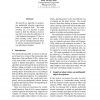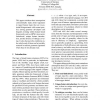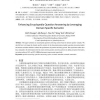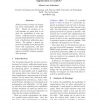ACL
2001
14 years 28 days ago
2001
We describe an algorithm for generating multimodal referring expressions, based on empirical data. The main novelties are (1) a decision to point based on both the efficiency of p...
ACL
2001
14 years 28 days ago
2001
This paper presents a method that assists in maintaining a rule-based named-entity recognition and classification system. The underlying idea is to use a separate system, construc...
ACL
2001
14 years 28 days ago
2001
The STOP system, which generates personalised smoking-cessation letters, was evaluated by a randomised controlled clinical trial. We believe this is the largest and perhaps most r...
ACL
2001
14 years 28 days ago
2001
This paper considers three assumptions conventionally made about signatures in typed feature logic that are in potential disagreement with current practice among grammar developer...
ACL
2001
14 years 28 days ago
2001
ACL
2001
14 years 28 days ago
2001
Techniques for automatically training modules of a natural language generator have recently been proposed, but a fundamental concern is whether the quality of utterances produced ...
ACL
2001
14 years 28 days ago
2001
Considering the difficulties inherent in the manual construction of natural language parsers, we have designed and implemented our system GRIND which is capable of learning a sequ...
ACL
2001
14 years 28 days ago
2001
We present a set of algorithms that enable us to translate natural language sentences by exploiting both a translation memory and a statistical-based translation model. Our result...
ACL
2001
14 years 28 days ago
2001
In this paper we discuss our approach toward establishing a model of the acquisition of English grammatical structures by users of our English language tutoring system, which has ...
ACL
2001
14 years 28 days ago
2001
Multi-processor systems are becoming more commonplace and affordable. Based on analyses of actual parsings, we argue that to exploit the capabilities of such machines, unification...




